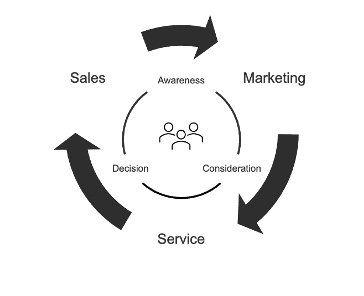Transitioning to Hybrid Selling: An Approach
Transitioning from a traditional, siloed selling organization to hybrid selling is complex especially when facing broad economic and cost containment headwinds. While maintaining the in-person experience is critical in enterprise B2B sales, balancing the right mix of channel engagement is also critical to success.
A practical, stepwise approach kick-started our learning path by identifying gaps and prioritizing areas of opportunity. Admittedly, our gaps were wide, but our go-forward strategy was decidedly narrow, focusing on people, process, and technology actions:
People — Growth mindset, career development, cross-functional engagement channels
Process — Planning frameworks, aligning sales process to buyer journey, digital campaigns, account-based strategies
Technology — Analytics, marketing automation, enablement, and virtual meeting platforms
One area strategically chosen as a starting point for hybrid selling was new product launches. Revamping our approach started by identifying strategic customer stakeholder groups, unmet needs, and buying processes. This fed our customer segmentation, account planning, and CRM go-to-market processes. Cross-functional engagement teams included representatives from digital marketing, product marketing, in-person and remote sales, commercial operations, service, support, as well as agency partners. We leveraged agile sprints to test and iterate tactics in early pilots and scaled to the rest of the organization as we learned. Sellers supported marketing with top-of-funnel engagement tactics and marketing supported sellers on pipeline acceleration programs for bottom-of-funnel opportunities.
Cross-team collaboration and account-based strategies engaging high-value customers through a diverse set digital and human-led touch points with a value proposition early in the sales process not only guided buyers towards our products but also strategically edged out competitors. We broke down commercial silos and iterated new methods of engagement to reach customers with a unified approach.
Value generating customer engagements and touch points
Marketing, Sales, and Service must strive to balance overlap and coordination across the buyer journey to meet the defined strategic objectives
Aligning and executing strategic priorities took a customer-centered view for the entire business, streamlined our sales cycle, and unlocked growth that extended beyond just identifying new opportunities. Embrace the opportunity to drive meaningful change, adapt to market shifts, and harness the power of integrated commercial strategies. The future of commercial success will be shaped by how selling organizations effectively adapt to the evolving B2B market.
